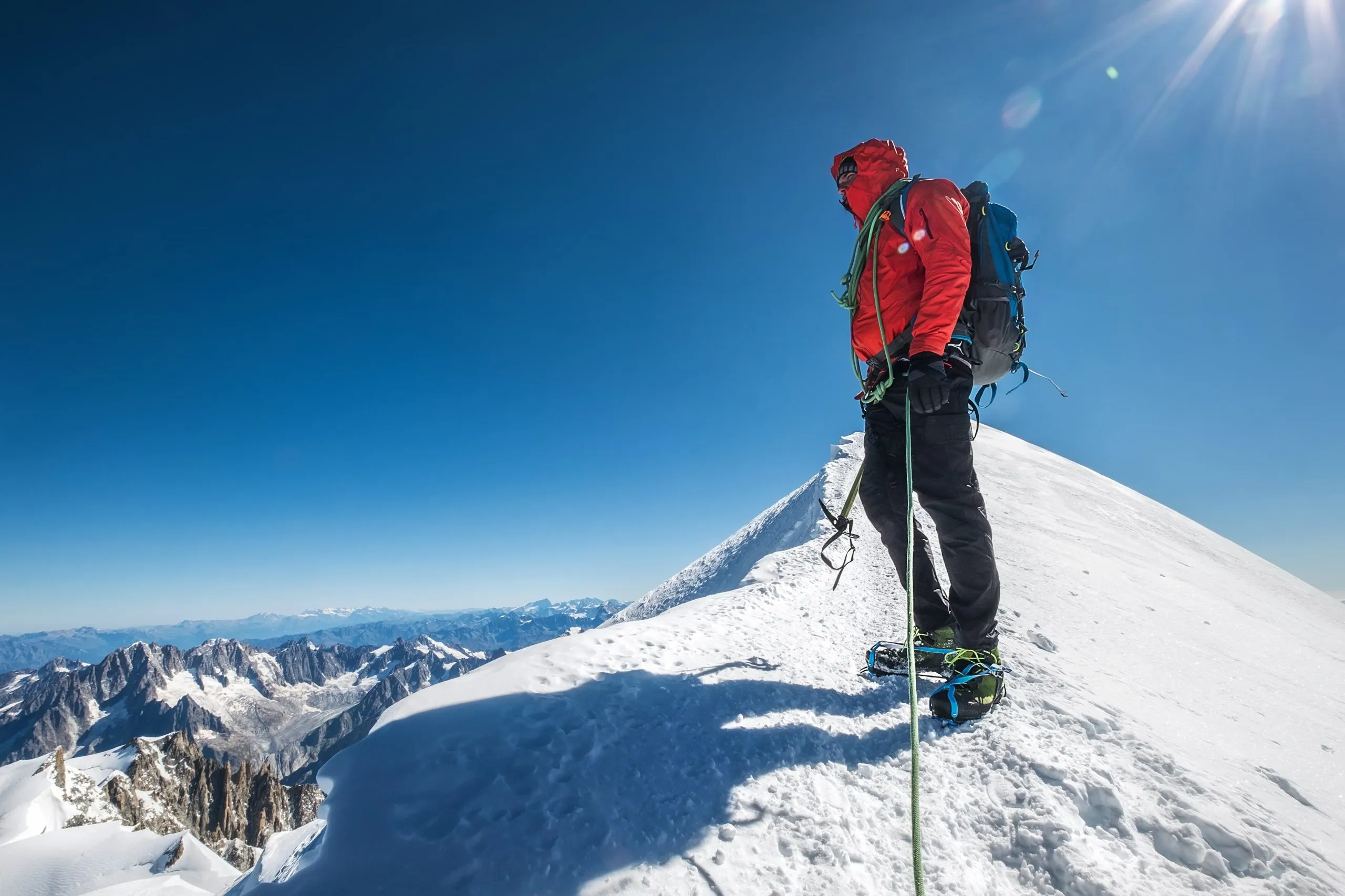The climb of Mont Blanc is a serious mountaineering venture. That means that not having a piece of specific equipment might make it impossible to summit or even start the climb. And because climbing Mont Blanc is a multiple-day expedition, you’ll have to take plenty of stuff with you, and there’ll be plenty of chances to forget an essential piece of gear.
That’s why we have prepared a complete checklist of all the things you need to take on your Mont Blanc expedition below. Check it when you decide on this adventure (so you know what to buy), check it while packing, and check it again before departing for Chamonix. You don’t want to miss anything on this list.

But if you forget something, it gets broken or doesn’t fit you, it’s not the end of the world. Chamonix is still in civilization. And with plenty of sports equipment stores of many price levels there, our Mont Blanc guides will gladly help you shop. If you want, you can also rent larger and more expensive pieces of equipment, like crampons and ice axes, from us, right there in Chamonix.
We will make sure you have all the necessary equipment before we set foot on the mountain. If you have any questions about gear before arriving in Chamonix, contact us.
Gear checklist
Technical equipment
Backpack
A simple and lightweight hiking backpack with a capacity of between 35-45 liters is recommended. You need to have one loop for carrying an ice axe on your rucksack, where you can also put the hiking poles when you switch.
Mountaineering boots
Insulated leather or synthetic B3 graded mountaineering boots with a rigid sole.
Mountaineering Ice Axe
A simple walking axe with a straight or slightly curved shaft that is 55-70 cm long, depending on your height.
Crampons
Standard steel mountaineering crampons with anti-balling plates (to reduce the buildup of snow underneath) of any type (C1, C2, C3).
Harness
A lightweight model, designed for mountaineering.
Helmet
Any mountaineering helmet will do, but make sure it fits under the hood of your waterproof jacket.
2 Screw carabiners with sling
Walking pole(s)
They will provide you with extra balance on an uneven terrain and make it easier for your knees, especially on the way down.
Clothing
Base Layer Top and Bottoms
Bring a few base layer tops, most long-sleeved, and a few short-sleeved for the hot days too. Merino wool base layers from Smartwool, Icebreaker or others serve their purpose very well because they offer good wicking properties and dry quickly. In any case, do not bring any cotton base layers, as they absorb moisture and therefore keep you cold, not warm. Also, bring at least two pairs of long or ¾ length bottoms.
Mid-layer fleece tops
A couple of thick fleece-type jackets or tops that you can wear between your base layer and outer layers. The “layering” approach offers the best heat retention and flexibility in warm and cold weather.
Insulation Layer
A down or PrimaLoft jacket is a very practical item to have ready to wear in the event of cold weather. It can stay in your rucksack as a spare layer and can come in very handy for sudden weather changes.
Softshell trousers
You want to wear a lightweight softshell or similar material on your legs. These types of trousers offer good enough protection from snow/ice and abrasion on rocks while still being comfortable to move in.
Hiking shorts or pair of trousers with zip-off legs
Useful for walk-ins to huts on hot days.
Waterproof jacket
Gore-Tex or other waterproof breathable jacket. Best to have a lightweight jacket that can be worn in the event of wet or windy weather but is packable enough to fit in your rucksack. Your insulated ski jacket will be overkill for being too hot and bulky.
Waterproof pants
Bring a pair of Gore-Tex or other waterproof breathable trousers, used in cold, wet or windy weather. They must be lightweight and easily packable, with side zips for putting on over your boots and crampons.
Sun hat and warm hat
Bring a wide-brimmed sun hat or baseball cap, plus a warm beanie style hat that covers your ears.
Light and thin gloves
A thin pair of fleece or softshell gloves for warm weather are a must.
Insulated gloves
You need to have a pair of waterproof warm gloves to wear on cold days.
Gaiters
These are useful to wear to keep snow out of your boots.
Socks
3-4 pairs of medium warmth socks of a mid-calf length.
Sun Glasses
Minimum category 3 that protects your eyes from the intense sunlight high up on the white glaciers.
Ski Goggles
These can be very useful if you encounter strong winds and poor weather.
Toiletries
Besides the things listed below, you can bring any other essentials you need. Just keep in mind that there are no shower facilities and generally no running water in the high mountain huts, so you have to carry everything with you.
Toothbrush and paste
A mini one is ideal since you want to save as much space as possible.
Soap
Wet wipes
Essential to try to maintain hygiene.
Tissues and toilet roll
Small and light quick dry towel e.g. a Lifeventure Soft fiber towel
Miscellaneous
Lightweight sleeping bag liner
A silk or cotton sleeping bag liner is now compulsory in all mountain huts.
Water bottle or Thermos
A water bottle or a hydration system (a camelback) is needed.
Head torch
Penknife
Personal First Aid Kit
Should contain:
- Plasters – of various sizes and possibly some adhesive wound dressings;
- Pain Killers – aspirin or Paracetamol/Nurofen;
- Antiseptic cream or wipes;
- Blister kit – Compeed and elastic tape to hold it in place (essential)!
Note: Guides will have comprehensive first aid kits and are qualified in mountain first aid.
Covid-19 kit
A mask and an anti-bacterial hand cleaner.
Sunscreen and Lip Protection
Ear Plugs
For noisy huts!
Camera
Optional but very nice if you have it.
Hold-all bag
For keeping gear not required on the trek. It will be left at the first hotel and collected on return.
Passport
Money
You will need some cash for food and drinks. There are some ATMs around, and most hotels, shops, and restaurants will accept credit cards, but most huts still accept only cash. You should allow about 25-35 Euros per day for lunch and drinks (the amount specified here is approximate and depends on your level of consumption).





